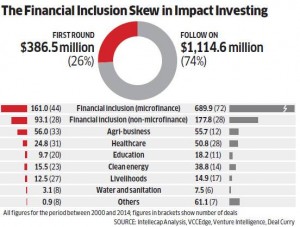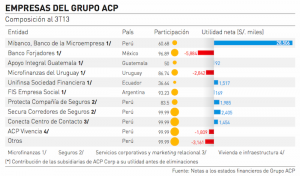Readers of this blog or the Next Billion blog will have detected a certain cynicism of mine regarding peer-to-peer organisations (P2Ps) operating in the microfinance sector. In fact most of my concerns are focussed upon Kiva. I find Zidisha a refreshing and innovative alternative to Kiva, but not without problems. MyC4 leads the way in transparency, but never quite took off, and recently closed down all operations outside Kenya. Kubaru remains too small. Lendwithcare are interesting, but perhaps not for the right reasons. I was disappointed at their recent blog post. It was so flawed, despite a decent premise, that I imagine they regret publishing it (see my comment below the article).
However, a fascinating development is underway currently that is potentially the first innovation in ages in the P2P space in a while, but could also be a disaster. It concerns MyC4’s latest and largest loan.
There are basically two models for intermediating funds. Wealthy investors and corporations lend substantial sums to specialised investment funds (MIVs – Microfinance Investment Vehicles), who then make large loans to Microfinance Institutions (MFIs). BlueOrchard is a good example of this. And P2Ps take thousands of small loans from individuals and lend them directly to poor clients, usually via an MFI.
| Intermediary | Lenders | Amount | Borrower | Amount |
| MIV | Corporate | Big | MFI | Big |
| P2P | Individuals | Small | Client (via MFI) | Small |
There are some exceptions to this. Triodos is an MIV but also takes funds from individual retail investors who can invest small sums. Zidisha is a “pure” P2P that does not go via an MFI. And there are some valid concerns regarding whether Kiva is a P2P at all in the strict sense of the word. But in essence this simplification suffices for the current discussion. MicroPlace was something of a hybrid: it took funds from individuals and made wholesale (large) loans to MFIs, but it collapsed.
MyC4 have decided to merge the two models (comparable to the MicroPlace effort). The source of funding is apparently similar to the traditional P2P model, i.e. lots of individuals bidding small sums, but rather than making hundreds of individual small loans to poor borrowers, the loans are lumped together into one €250.000 loan to a Kenya MFI called Premier. Thus the heart-warming feeling of making individual loans to individuals is partially eroded. One hypothesis about the success of the microfinance P2P sector, as typified by Kiva, is that it is this emotional connection that draws people in, offering a fluffy feeling (valid or otherwise) to the lender that he or she has helped an individual person. Thus the MyC4 model enables us to observe the impact of removing this effect in relative isolation.
Other differences with this wholesale loan are that the MFI is assuming the credit risk of the underlying borrowers, and also the foreign exchange risk. But in exchange for this reduced risk, the MFI will cap the interest it will pay to the investors at 4%, which is substantially lower that MyC4’s typical P2P loans. Minor issues raised by MyC4 users (myself included) are that the due diligence of this MFI seemed scant – it received a stellar risk rating despite being a start-up, there was no discussion of the interest rates the MFI will subsequently charge the poor etc. MyC4 responded to these questions adequately.
So far so good. The bidding ends this month, and we are watching it closely. I have not yet bid, for reasons which will come clear shortly. But there is a little catch to this loan that is potentially a serious alarm bell.
On the 30th of June I downloaded the 50 largest bids on this loan. This is the maximum you can view on a single page on MyC4, and covered a substantial portion of the entire bids, which was a little over 600 at the time. Bids on this loan ranged from €5 to €57,599. The 50 largest bids started at €122, and represented marginally over 50% of the entire bids at that point. So, what we see is that a few big investors account for the lion’s share of the bidding – nothing particularly surprising there. However, dig a little deeper and there is a weird anomaly.
80% of the capital raised by the top 50 bids are from MyC4 themselves. They are bidding on their own loans. MyC4 Foundation, Kjaer Group, MDG3, MyC4 Board, The Way Forward, MicroFund 1 and KBFUS are all controlled by MyC4, or more specifically the founder and CEO Mads Kjaer. There is nothing fundamentally wrong with this, I am not suggesting anything murky here. But is it normal for the main customer in a shop to be the owner of the shop? Total funding from the top 50 lenders on 30th June was €120,011 of which €96,530 (80%) was from MyC4 controlled entities.
I mentioned that the interest rate is capped at 4%. This is the interest paid to the lenders. In fact there are two additional costs to the business: fees and interest paid to MyC4 and the facilitator of the loan. These add approximately 4% to the cost of the loan, and the facilitator in this case happens to be none other than MyC4 East Africa, a subsidiary of MyC4. So, we have a slightly circuitous scenario: MyC4 bidding on its own loans, earning interest as a direct lender (typically at 4%), earning approximately this rate again via its commission to the MFI and via its own facilitating subsidiary. Again, I am not suggesting this is wrong. It is simply a rather bizarre way to lend money to a bank in Kenya. Obviously the upside to MyC4 is that it encourages other lenders to jump on the bandwagon and also lend, i.e. MyC4 can leverage its own loan to the bank.
So, today I revisited the website and just over €7,000 new bids from these MyC4-related entities have emerged. Time is running out, and the bid is filling very slowly, particularly from the non-MyC4-related folk such as you and I. What are the implications for this?
I suspect that MyC4 do not want this pioneering loan to fail. They will inject the funds required to top this up at the required interest rate. MyC4 have deep pockets, and have already channelled over €103.000 into this bid (which currently stands at just over €142.000 in total), so MyC4 is by far and away the main lender here. If this fails it will be embarrassing for MyC4. The MFI will be disappointed. All the legal fees, contractual expenses and due diligence costs will have been wasted. Smaller lenders will be irritated that they tied their capital up for a couple of months during the bidding process only to have it returned to them (without interest). And MyC4 has focussed all its operations in Kenya, so a failed loan of this size would not do their reputation any good.
But perhaps most worryingly, this potentially innovative form of intermediating capital will have failed at the first hurdle. There are exactly 3 weeks until the bidding closes, and this loan requires €108.000 more to be filled. Judging from the progress to date, this is unlikely to come from the smaller lenders, so MyC4 face only 3 options: risk the loan failing; get some big lenders in promptly; or make up the difference themselves. The beauty of all this is that thanks to the stellar transparency of MyC4, we will see exactly how this plays out, in real time. Sure, MyC4 could discreetly bid using the “anonymous” option, but this would be highly suspicious – I doubt they would attempt so unsophisticated a trick.
So, what can we conclude from all this? First, once again MyC4 are innovating and doing so transparently. Full marks for that. This loan could send an important signal to the P2P sector. If this is successful, and lenders are not perturbed by the lack of smiling faces of women with goats and sewing machines, then this is certainly a more efficient mechanism for channelling funds into microfinance versus the traditional P2P model. Crowd-funded, but wholesale distributed. This will result in a lower cost of capital, and less effort (with the associated operating costs) for the MFI, which will hopefully pass to the clients via reduced interest rates.
But, the evidence to date suggests that the regular “crowd” lenders have not been too impressed with this. The causes are hard to discern – it could be the lack of the fluffy feeling of traditional P2P lending (photos of women with goats etc). But it also could be simply that the interest rate is too low. Or that they are hesitant to bid on a new model, especially to a start-up MFI without a track-record.
Secondly, while this demonstrates how woefully un-transparent are institutions such as Kiva, it also demonstrates that such stellar transparency comes at a price – MyC4 are likely not too keen for everyone to know that they are the main bidder, and the provider, earning fees in the process.
Thirdly, this does raise some questions about alignment of interests. MyC4 has information about this loan that the regular lenders do not, and also additional income streams from this loan beyond the simple interest earned on bids (fees etc.). It also has its own reputation at stake. By sitting on both sides of the table (administrating and bidding on a loan), but with asymmetric information, this could provide a conflict of interest. For example, suppose this loan is successful and wholesale lending takes off, and we see MyC4 bidding on some such loans, but not others. If we then see that MyC4 is consistently bidding on the better, non-defaulting loans, and not on the problematic loans, could this be considered a form of insider-trading? I have no reason to suppose MyC4 have any incentives other than to grow the platform, but the question always remains when people sit on both sides of the table and have different levels of information. It creates doubt.
One key example of the asymmetric information available to MyC4 and not to the bidders is simply that MyC4 can see the auto-bids, while regular users cannot. So they know already to what extent current lenders (whom MyC4 are competing against in this Dutch auction process) are willing to reduce the interest rate charged. MyC4 could benefit hugely from this information particularly in the later stages of the bidding process, and it would be extremely tempting for them to use this.
Finally, there may be an ironic self-fulfilling prophecy here. If I am correct, and the loan is slow to fill as the deadline approaches and MyC4 have to cough-up the difference, there is an obvious arbitrage opportunity. Two conditions need to be met for this loan to clear – the full €250.000 has to be raised, and the average interest rate has to be at or below 4%. If either condition is not met, MyC4 have to step in with the required amount at a sufficiently low interest rate to reduce the average rate to 4%. Anyone bidding at this stage, with an interest rate of say 20%, is fairly guaranteed to win their bid. There are enough bidders asking above 20% (up to 50% in fact) that if any bidders are competed out of the bidding process it is unlikely to reach down to the 20% level. And if the bid is unsuccessful, or if MyC4 bid such a vast sum that even a 20% loan is not accepted – so what – you lose nothing, the funds are returned to your account. So, essentially there could well exist an opportunity to exploit the goodwill and motivations behind MyC4. Obviously, if enough people do this then it becomes a self-fulfilling prophecy – if enough people anticipate that MyC4 will step in that they increase their last-minute bids accordingly, perhaps MyC4 will not need to step in after all!
Anyway, watch this space – this is an interesting quasi-experiment acted out in full view. It will likely have implications whatever happens. On the one hand we see Kiva moving in the opposite direction, toward the pure P2P model (as developed by Zidisha). MyC4 is essentially moving towards the MIV model (crowd-funded, wholesale distributed), and perhaps they can succeed where MicroPlace failed. But let’s not forget three important factors here:
- However microcredit is financed, it is the impact on the borrowers that determines the ultimate success or failure.
- The loan will still cost the MFI at least 8%, and an MFI able to access traditional MIV funding may find that more attractive.
- MyC4’s existence is essentially subsidized by its founder and related parties. At some point this subsidy will run out. MyC4 has been around for some years and has not yet demonstrated a scalable, self-sufficient lending model. Even if this wholesale loan is filled, it may be premature to crack open the champagne. Unless, of course, MyC4 are paying!
Good luck to MyC4 on this, and I will formally ask them to comment on this post if they wish.






